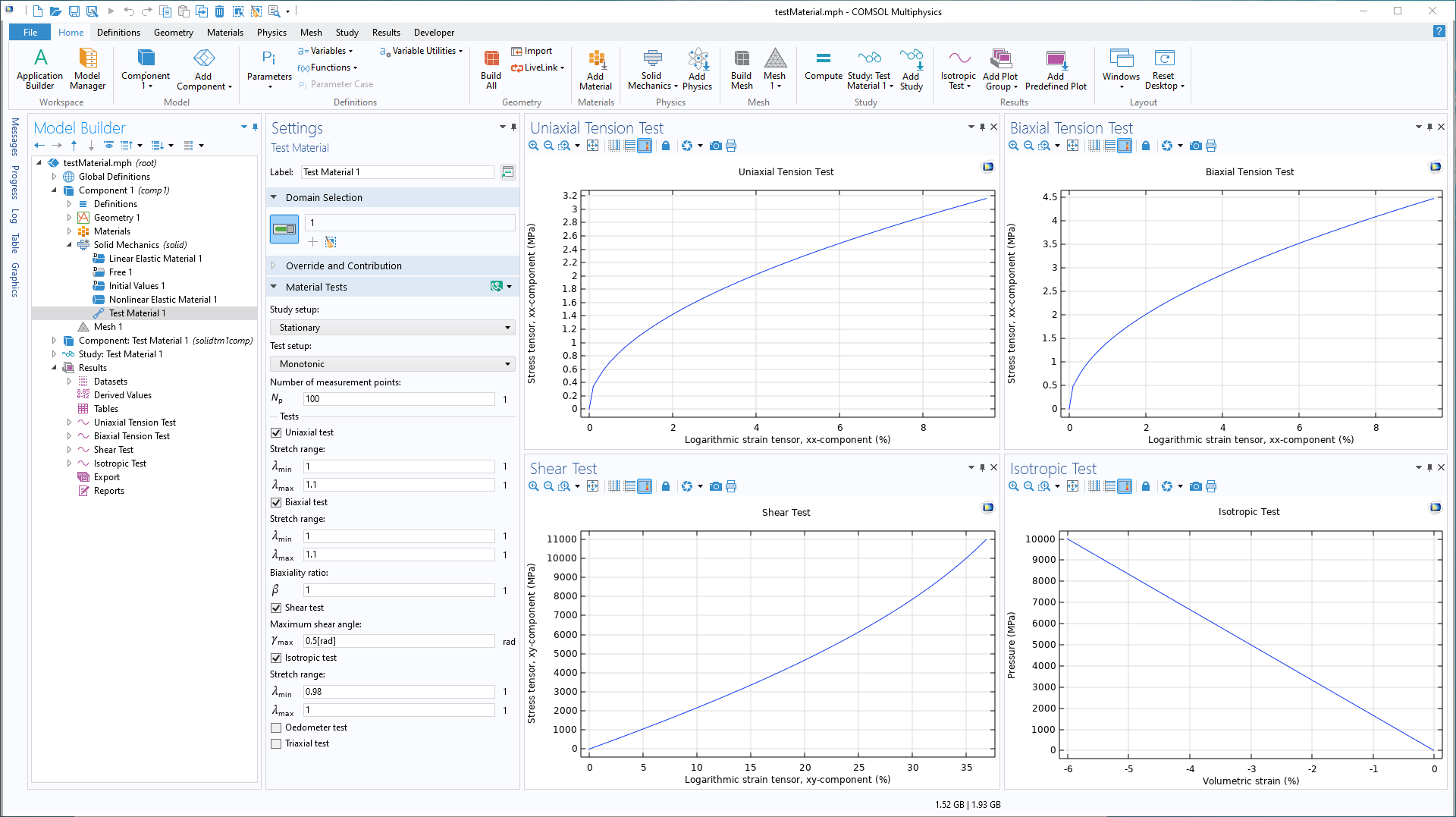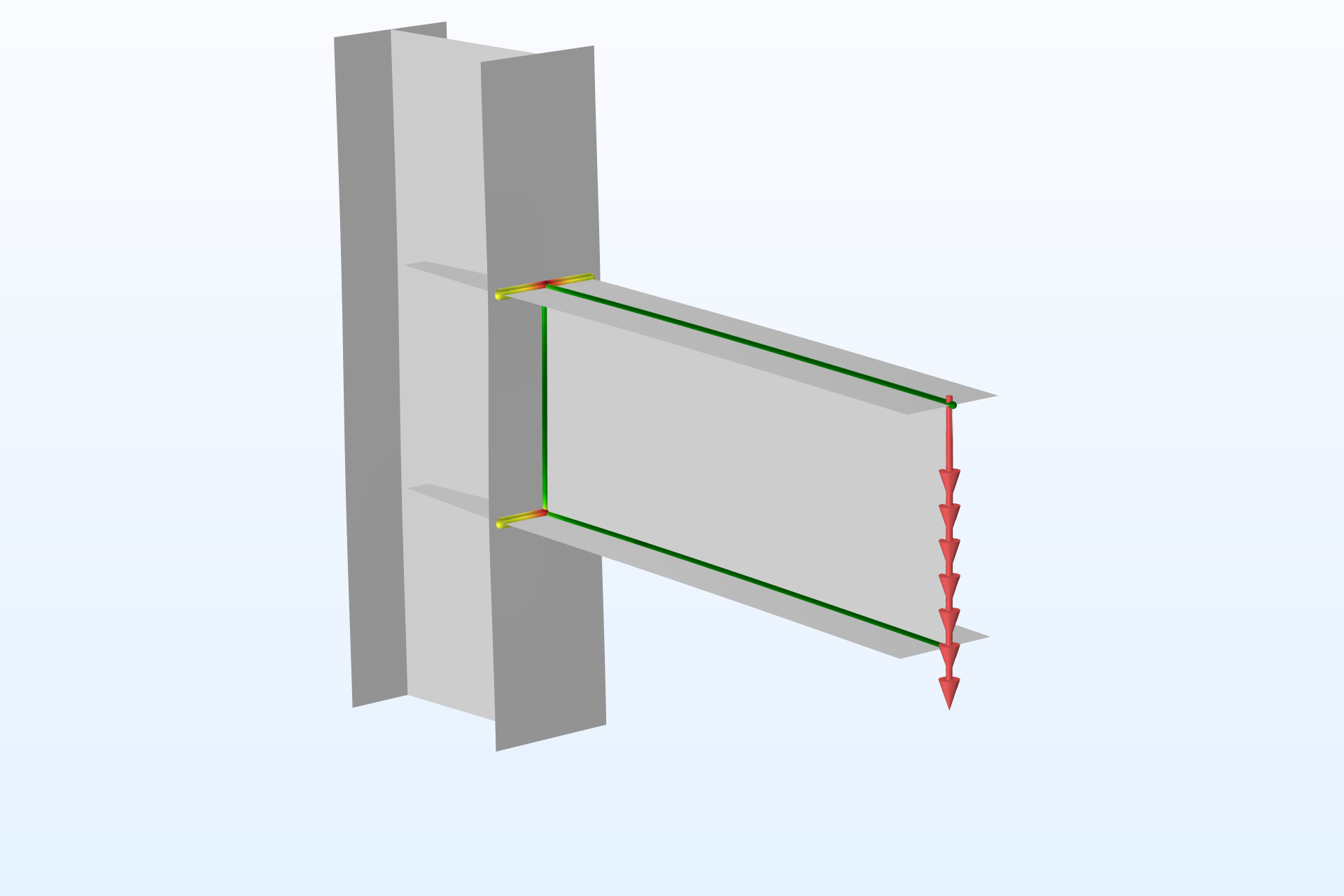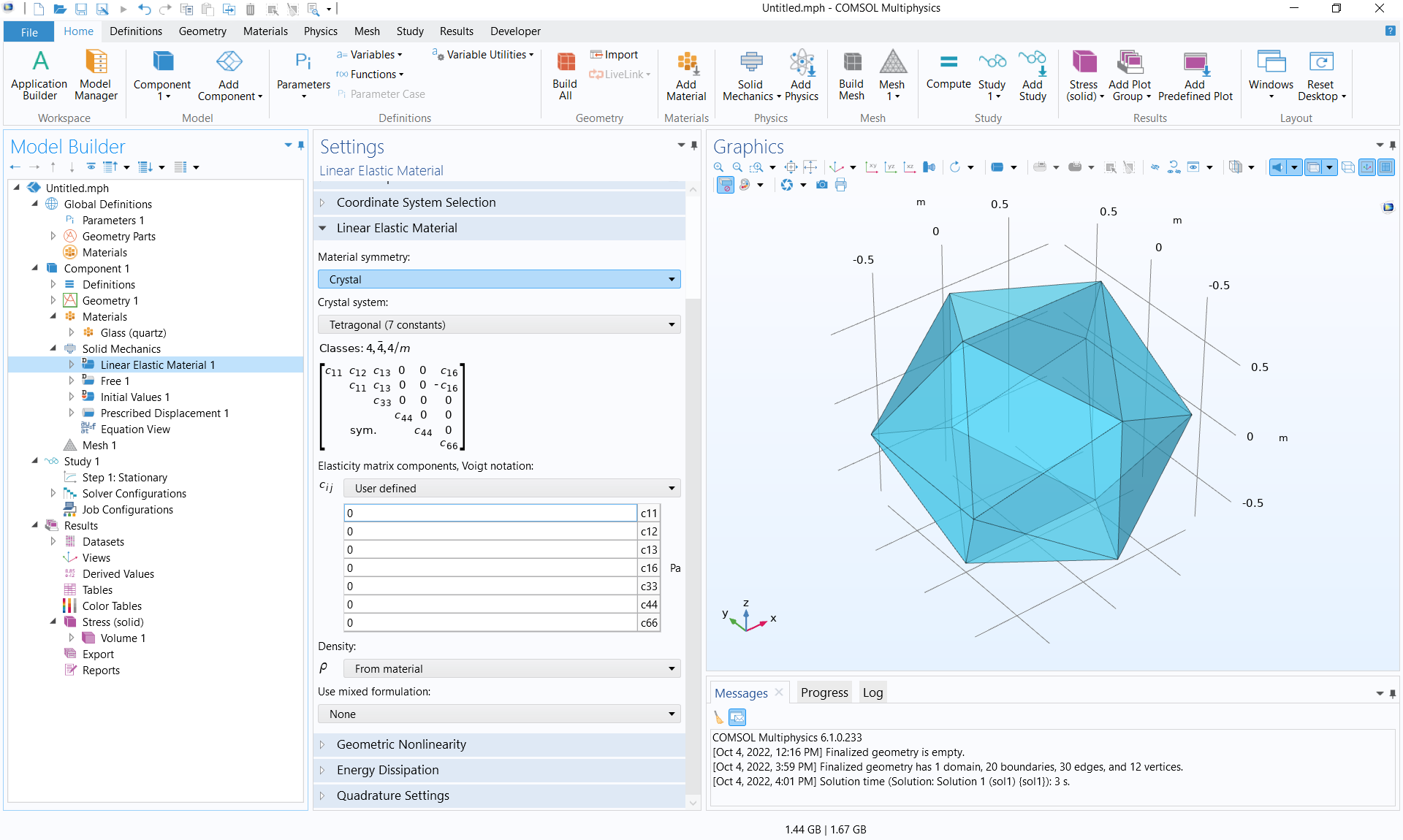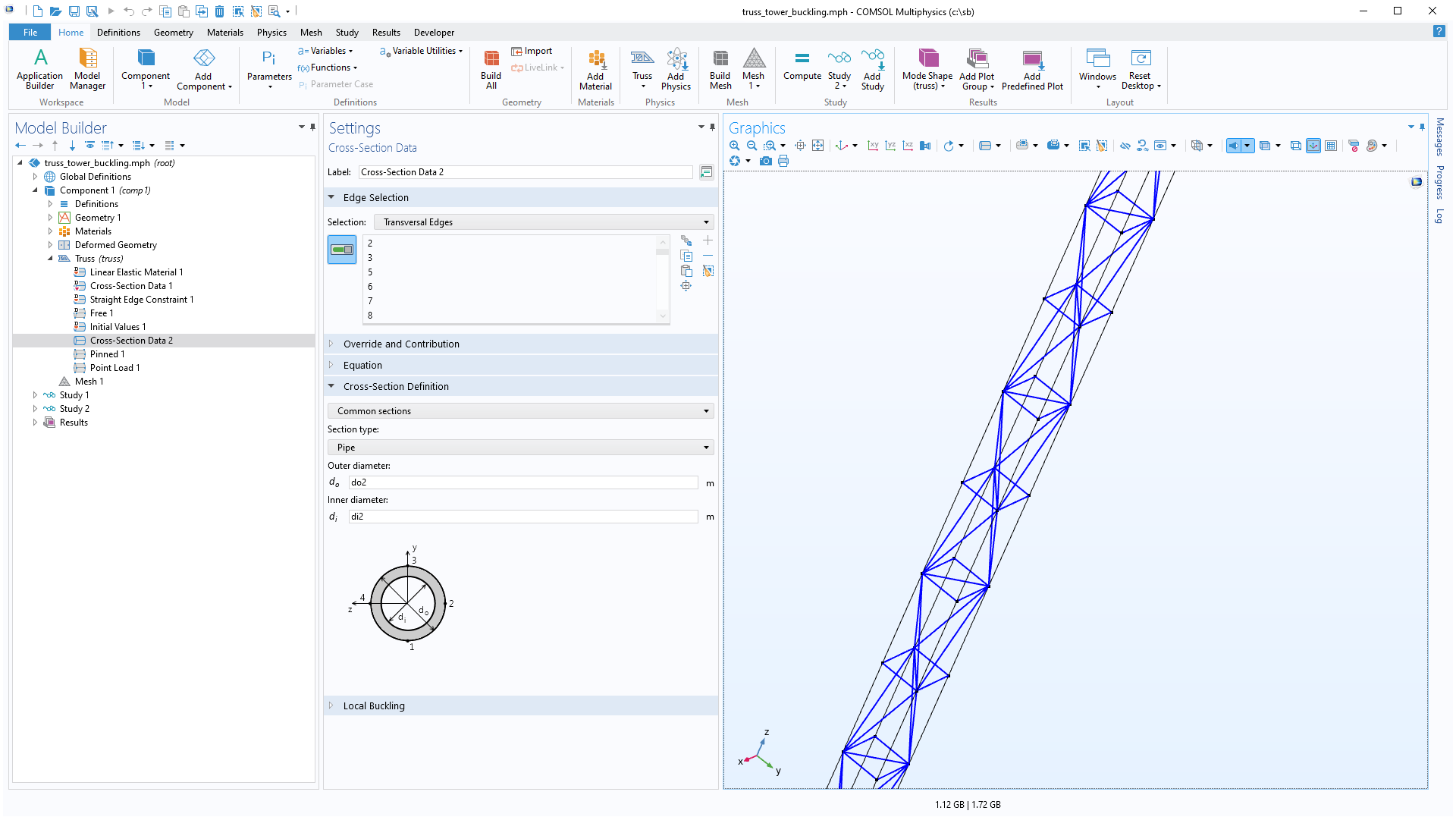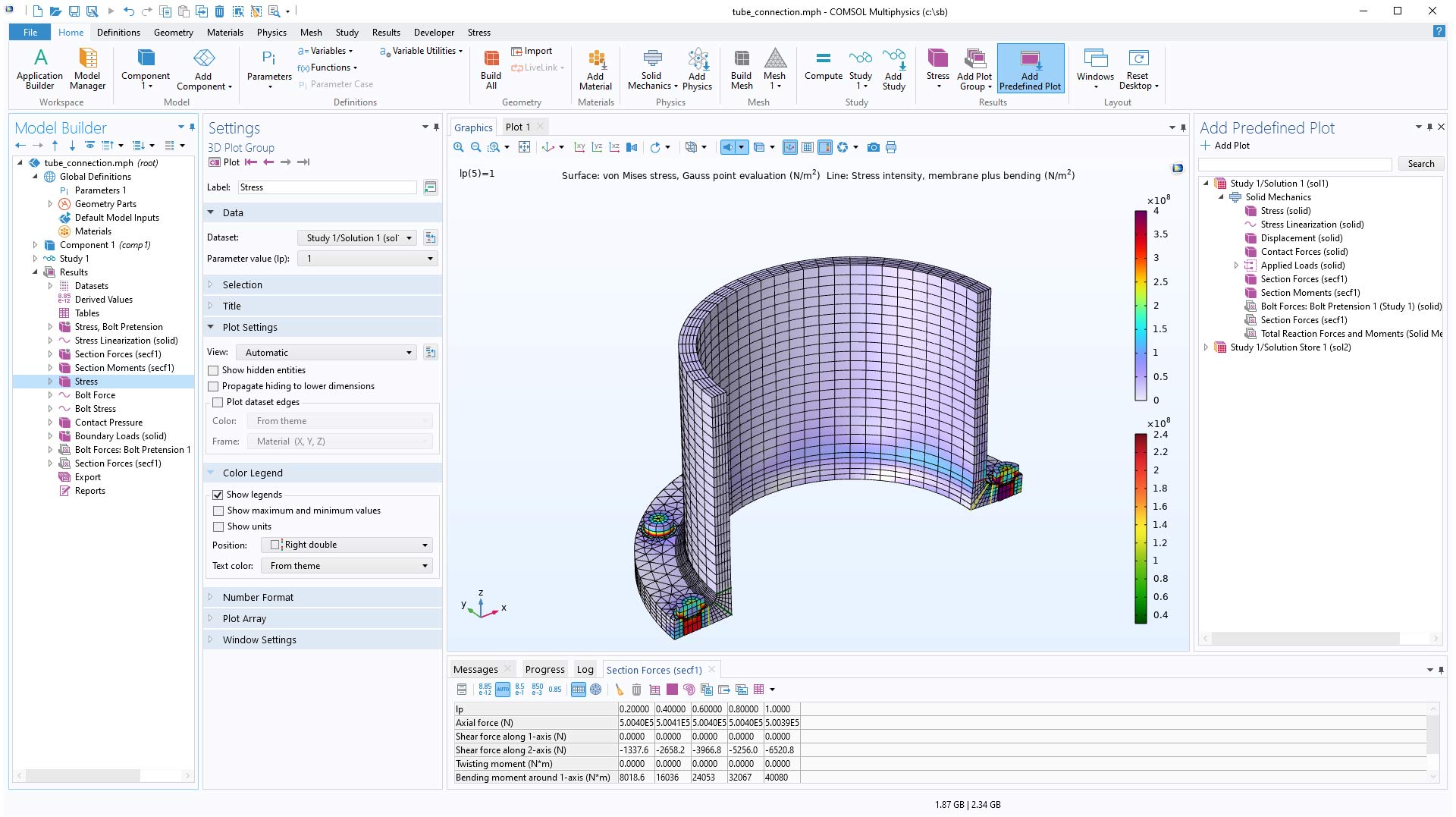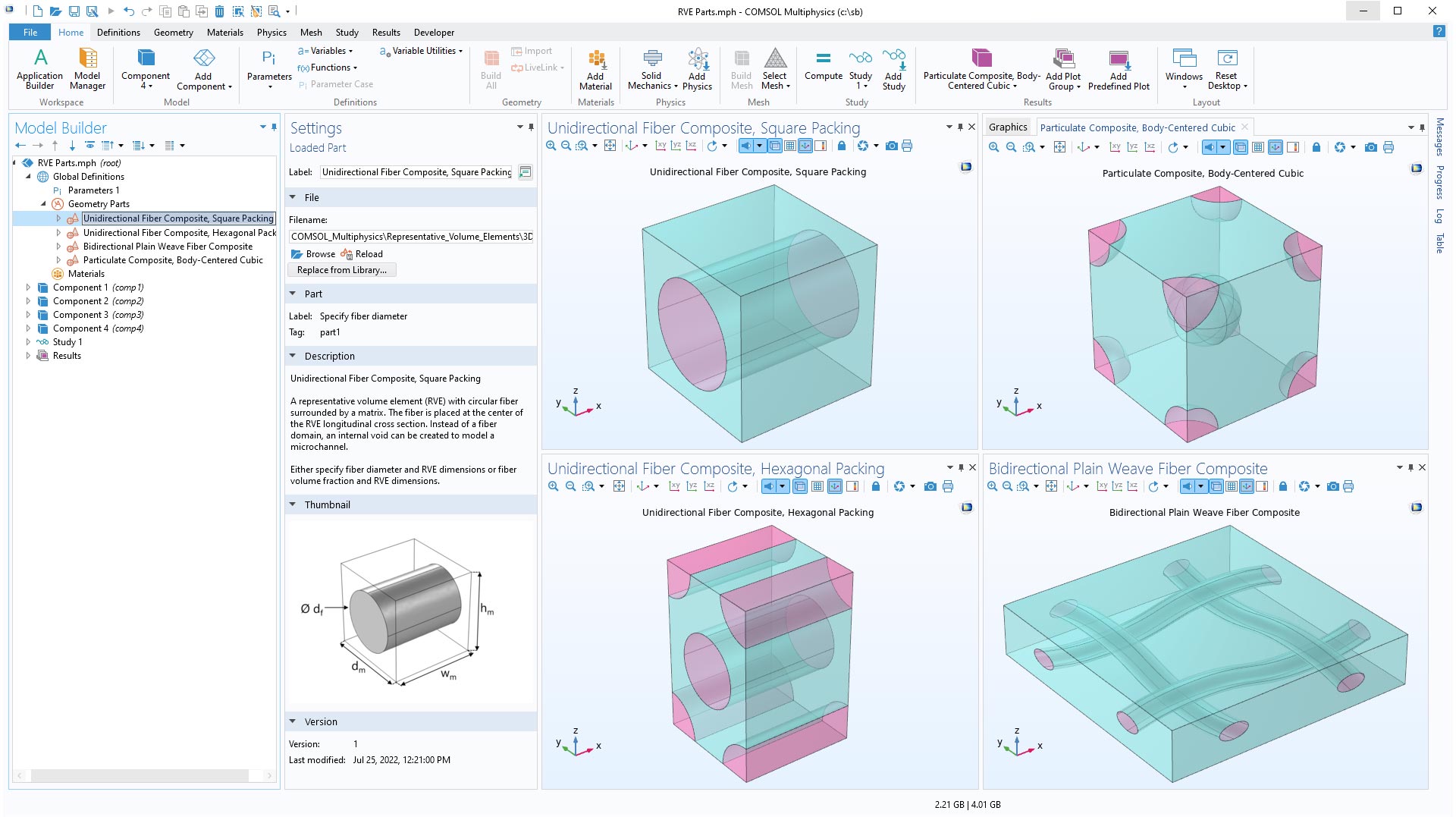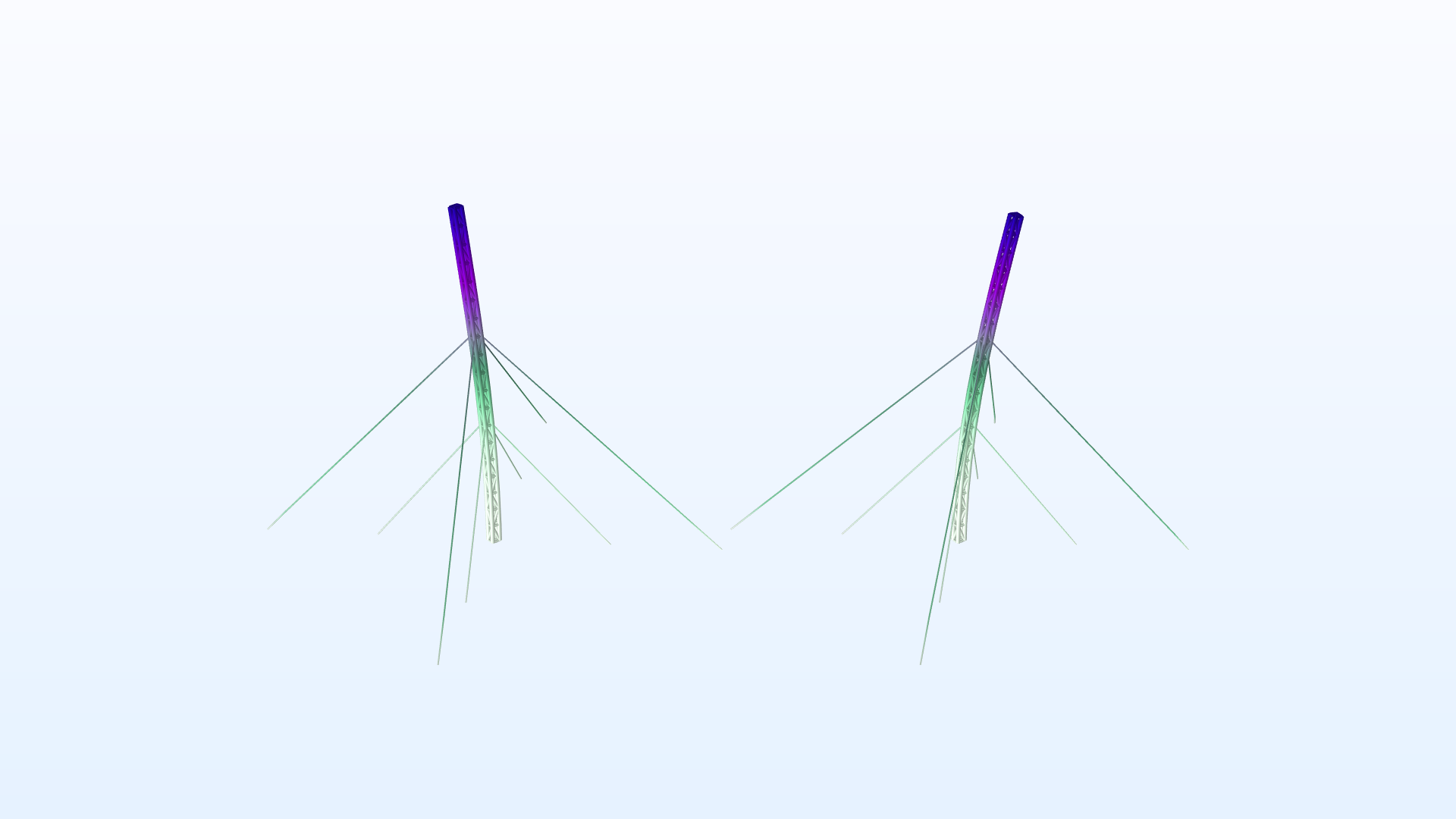support@comsol.com
Structural Mechanics Module Updates
For users of the Structural Mechanics Module, COMSOL Multiphysics® version 6.1 provides contact modeling enhancements, the ability to add linear and nonlinear materials on boundaries, and a new feature that numerically tests and verifies the behavior of a material model for a given set of material properties. Learn about all of the Structural Mechanics Module updates below.
Contact Modeling Enhancements
Several additions and improvements have been made to the contact modeling functionality.
- A new, faster contact search algorithm has been implemented. It is particularly advantageous for large 3D models.
- Nitsche's method, a new method for formulating the contact equations, has been added. It is a robust method that does not add any extra degrees of freedom.
- New, more stable formulations of the contact equations have been added for all contact models.
- Formulations for shells and membranes have been improved. Now, the actual surface on curved geometries is used.
- Support for self-contact has been improved. The formulation is now symmetric between the two sides of the contact pair.
Animation of an elastoplastic pipe forced into a conical hole. Self-contact occurs in several places.
Solid Mechanics Interface in 1D
The Solid Mechanics interface is now available for 1D and 1D axisymmetric components and does not require any additional product to use the basic functionality. In the transverse directions, different combinations of plane stress, plane strain, and generalized plane strain can be selected. There are several multiphysics applications in, for example, battery modeling, acoustics, and thermal–structure interaction where a 1D model can be useful for providing important insights into a physical phenomenon. Note that functionality for intercalation strains in batteries is included in the Battery Design Module. For more advanced 1D modeling, additional features are available when the Solid Mechanics interface is used in conjunction with the MEMS Module, Multibody Dynamics Module, or Acoustics Module.
A coupled thermal–structural problem with contact in 1D axisymmetry. Note that the underlying representation here is simply 1D elements along a line, whereas the results are expanded to a circular geometry for better visualization.
Numerical Testing of Material Models
For complex material models, in particular those that are user defined, it is important to investigate how a model behaves under various loading conditions. The new Test Material feature in the Solid Mechanics interface can automatically set up a small one-element model with appropriate boundary conditions and study steps for several different loading conditions. The loading can be quasistatic or time dependent, monotonic or cyclic. You can see this new feature in the updated Isotropic Compression with Modified Cam-Clay Material Model and Primary Creep Under Nonconstant Load models.
Materials on Boundaries of Solids
A wide range of linear and nonlinear material models are now available to use on internal or external boundaries. This can be used to model glue layers, gaskets, or claddings, for example. Such layers can use different assumptions, ranging from full 3D to only in-plane strains. When you use the Composite Materials Module in conjunction with the Structural Mechanics Module to implement these models, the boundary materials can even be multilayered. The existing Heating Circuit model showcases this new addition.
Physics Interface for Wires
A new Wire interface has been added for the analysis of systems of cables or wires, which can be done separately or in conjunction with other types of structures. The wires can be prestressed or sagging under self-weight. You can see this new functionality in the new Linear Buckling Analysis of a Truss Tower with Dead Loads tutorial model and the following existing models:
Forces in a grid of wires under a gravity load when the support points are moved inward. Part of the grid comes to rest on a rigid surface.
Multiphysics Interfaces for Thin-Film Damping
Two new multiphysics interfaces for thin-film damping have been added: Solid Thin-Film Damping and Shell Thin-Film Damping. They combine a Thin-Film Flow interface with Solid Mechanics or Shell, respectively. There are also two new multiphysics couplings that facilitate thin-film damping: Structure Thin-Film Flow Interaction and Shell Thin-Film Flow Interaction. These couplings are not limited to thin-film damping; you can also use them to model lubrication and cavitation, for example.
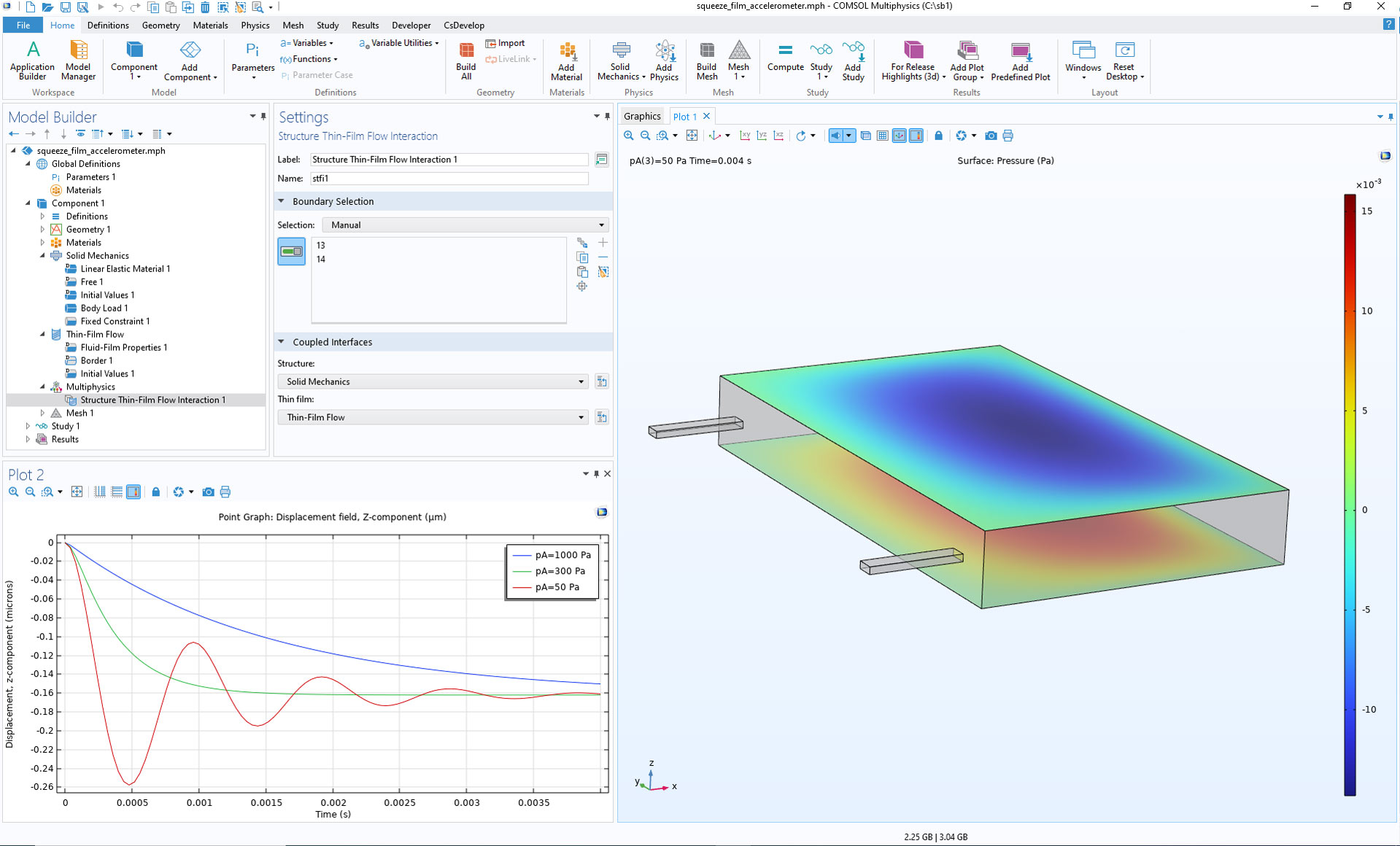
Buckling Analysis with Dead Loads
When searching for a critical buckling load, there are some situations where there are more than one system of loads, and one of them can be considered to be fixed. For example, a gravity load can be considered fixed (a dead load), whereas a service load can be considered not fixed (a live load). Even if you only want to compute the critical level of a service load, the dead load will still influence the risk of buckling. This type of analysis is now built in and can be viewed in the new Linear Buckling Analysis of a Truss Tower with Dead Loads model.
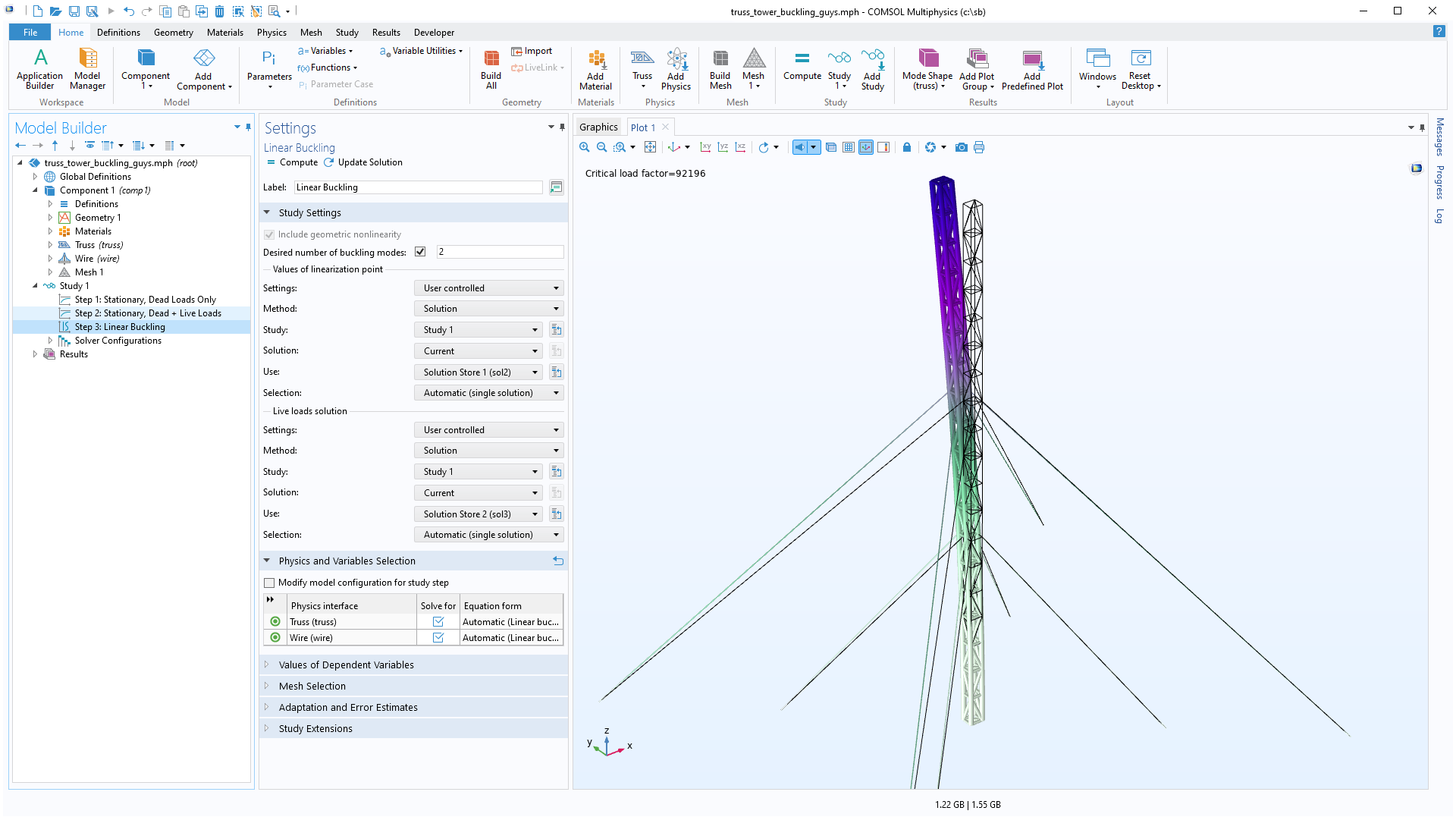
Wear for Shells and Membranes
Similar to the functionality that is already available in the Solid Mechanics interface, the Wear subnode has been added to the Shell and Membrane interfaces. This feature makes it possible to compute wear that reduces the thickness of shells and membranes due to frictional sliding. The same technology makes it possible to add user-defined expressions for the rate of thickness change. This can be used to model, for example, corrosion or electrodeposition.
Wear on a shell surface due to frictional sliding of a cylindrical solid object. The visualization is accomplished using a Shell dataset, giving the impression that both parts are 3D solids.
New Method for Connecting Assemblies
Nitsche's method has been added to enforce continuity between boundaries in assemblies. It has two important advantages when compared with classical pointwise constraints:
- It causes significantly less local disturbances in the solution when the meshes on the two sides are not conforming.
- Since no constraints are added, the numerically sensitive and sometimes computationally heavy constraint-elimination step is avoided.
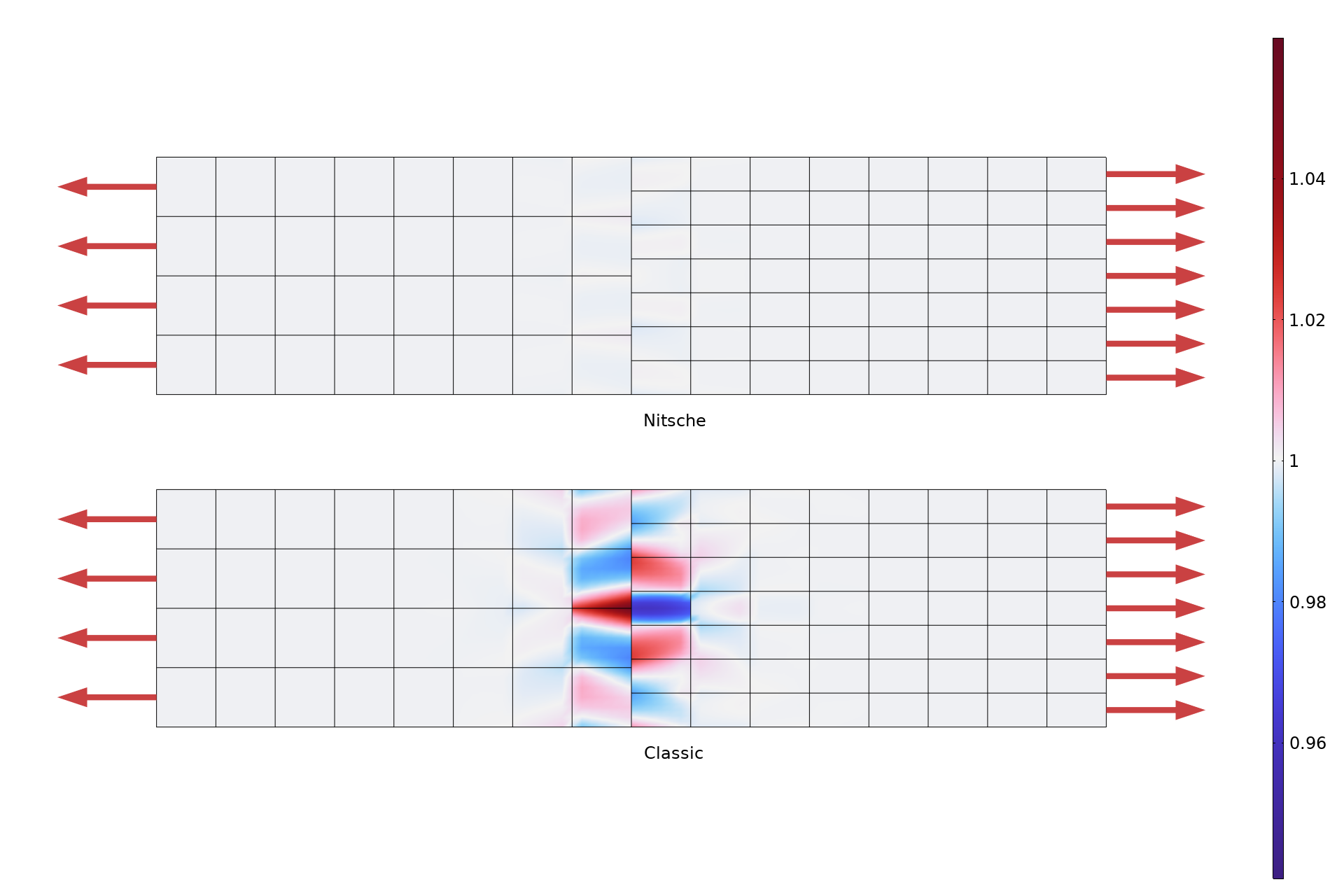
Component Mode Synthesis Enhancements
It is now possible to use shell elements in component mode synthesis (CMS) analyses. There are also several general improvements that make it easier to set up models for CMS analyses.
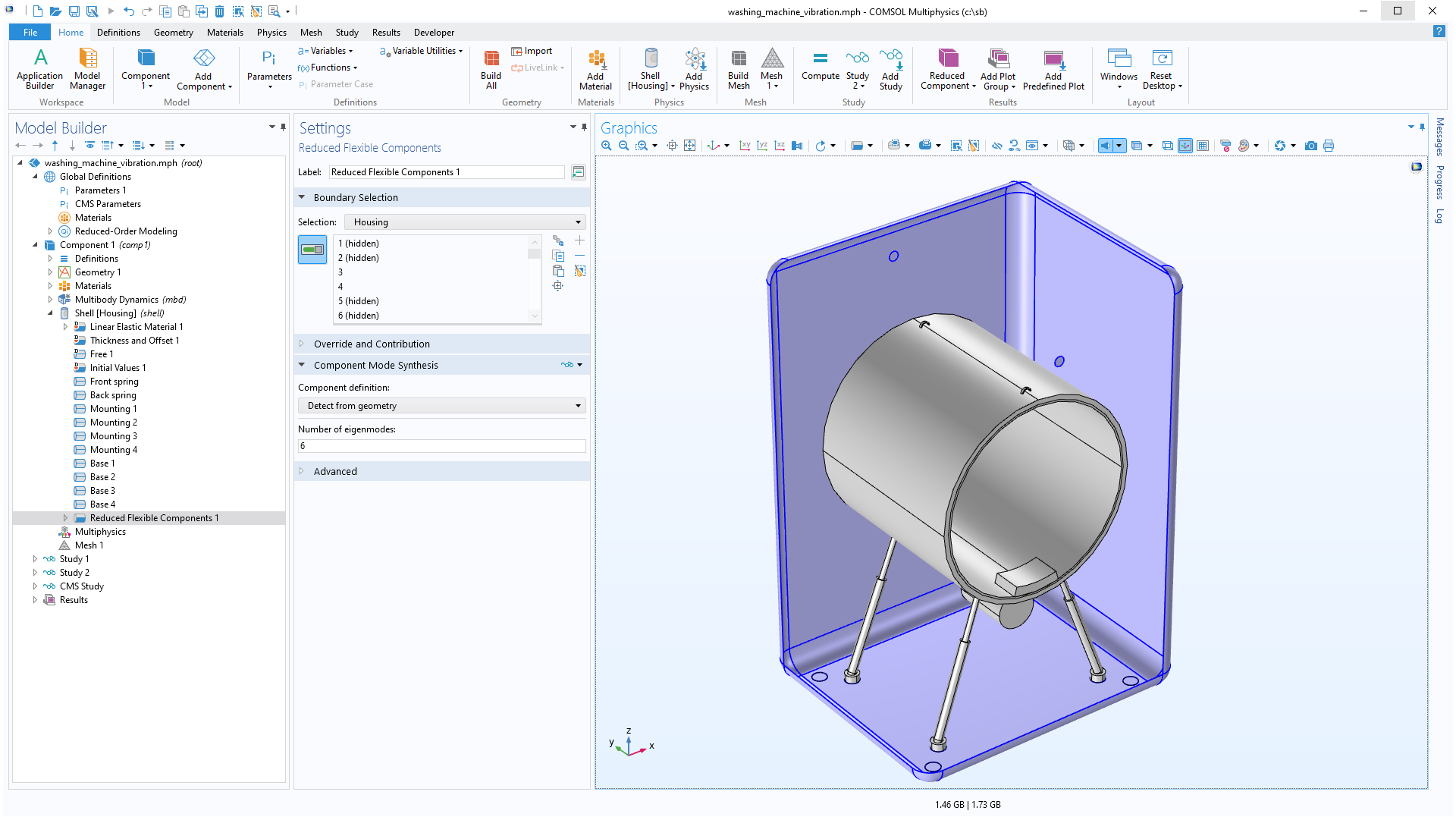
Base Excitation
It is common that the dynamic loading on a structure consists of a certain acceleration of all its support points. Examples of this are when a part is attached to a shaker table for testing or when a building is subjected to a ground acceleration with a long wavelength. This type of loading can now be more naturally described using the new Base Excitation feature. It is well suited for random vibration analysis. You can view this update in the existing Shock Response of a Motherboard and Random Vibration Test of a Motherboard models.
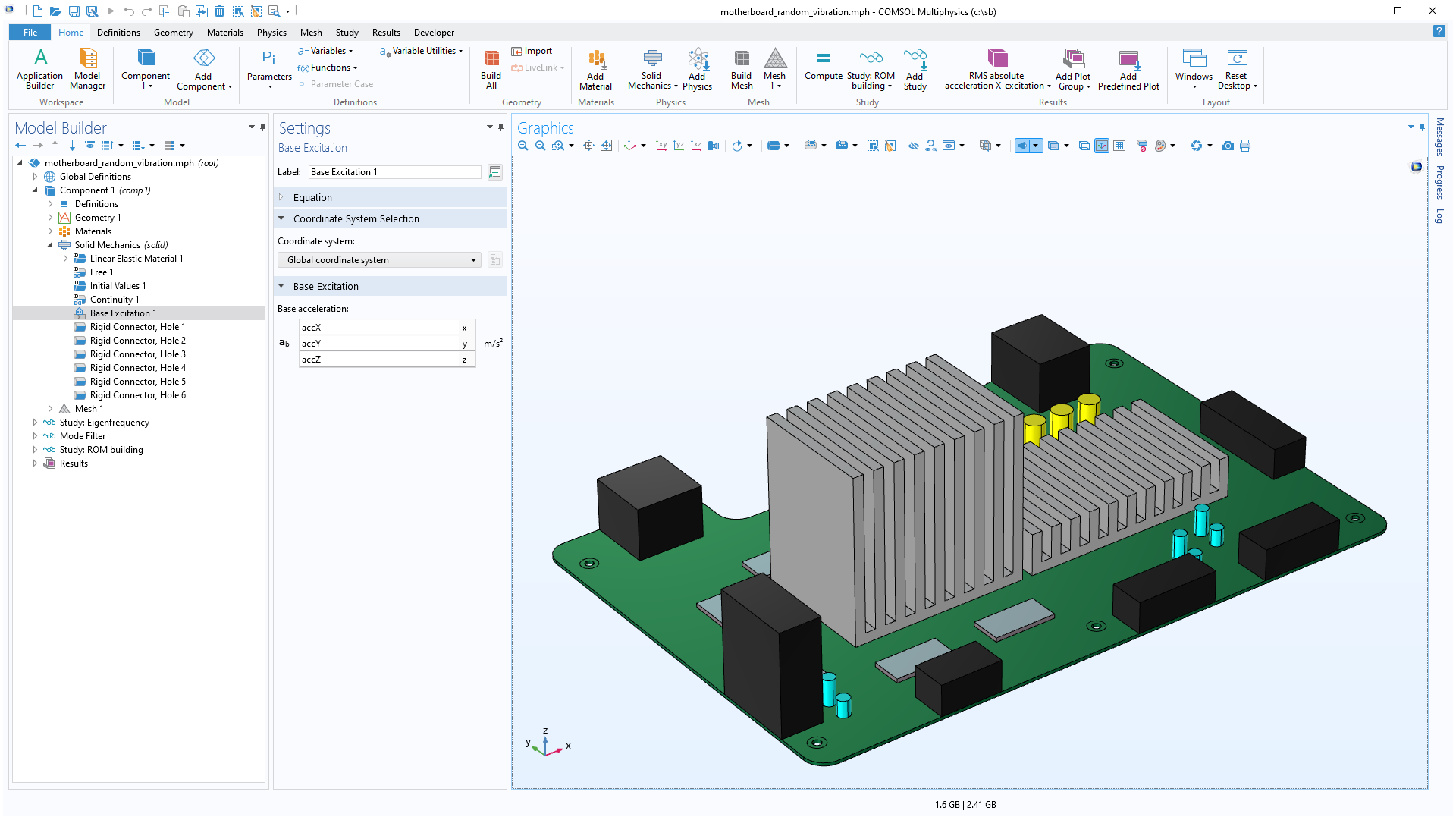
Loads Given as Resultant
For boundary loads and sets of point loads, you can now specify the total force and moment with respect to a given point by selecting the Resultant option from the Load type list. This makes it easier to apply load resultants without either imposing artificial constraints or making long calculations of the actual load distributions. It is possible to control the assumed shape of the load distribution.
A bending load given as a moment resultant is applied to the end of a beam, modeled as a 3D solid. The actual load distribution is shown by arrows.
Weld Evaluation
For welded structures, being able to predict the stresses in the welds is an important design aspect. In the Shell interface, you can now evaluate stresses along joined edges. The method is semianalytical in the sense that the weld is not modeled in the geometry, but it is represented by its properties. Single-sided and double-sided fillet welds as well as butt welds can be evaluated.
New Inputs for Anisotropic Materials
For the Linear Elastic Material feature, several new options for entering elastic constants have been added:
- Orthotropic materials can now be described by crystal data for seven different types of crystal systems: cubic, hexagonal, trigonal with six constants, trigonal with seven constants, tetragonal with six constants, tetragonal with seven constants, and orthorhombic.
- Input for transversely isotropic materials is supported, reducing the number of inputs for this class of materials.
- A general anisotropic material can now, in addition to the elasticity matrix, be represented by its compliance matrix.
Improvements for Rigid Connectors
The Rigid Connector is an important tool for abstract modeling, such as when applying loads and connecting objects. Its functionality has been augmented in three respects:
- It is now possible to disconnect selected degrees of freedom, such as in directions given by a local coordinate system. With this option, it is possible to release excessive constraints and reduce local stress concentrations.
- For two-point rigid connectors in 3D, it is possible to automatically suppress the potential rotational singularity.
- As a new default, the degrees of freedom that are generated by rigid connectors are now grouped together in the study sequence. This can dramatically reduce the number of nodes in the model tree and makes it easier to apply manual scaling for the convergence tolerance. The same change also applies to the Attachment feature.
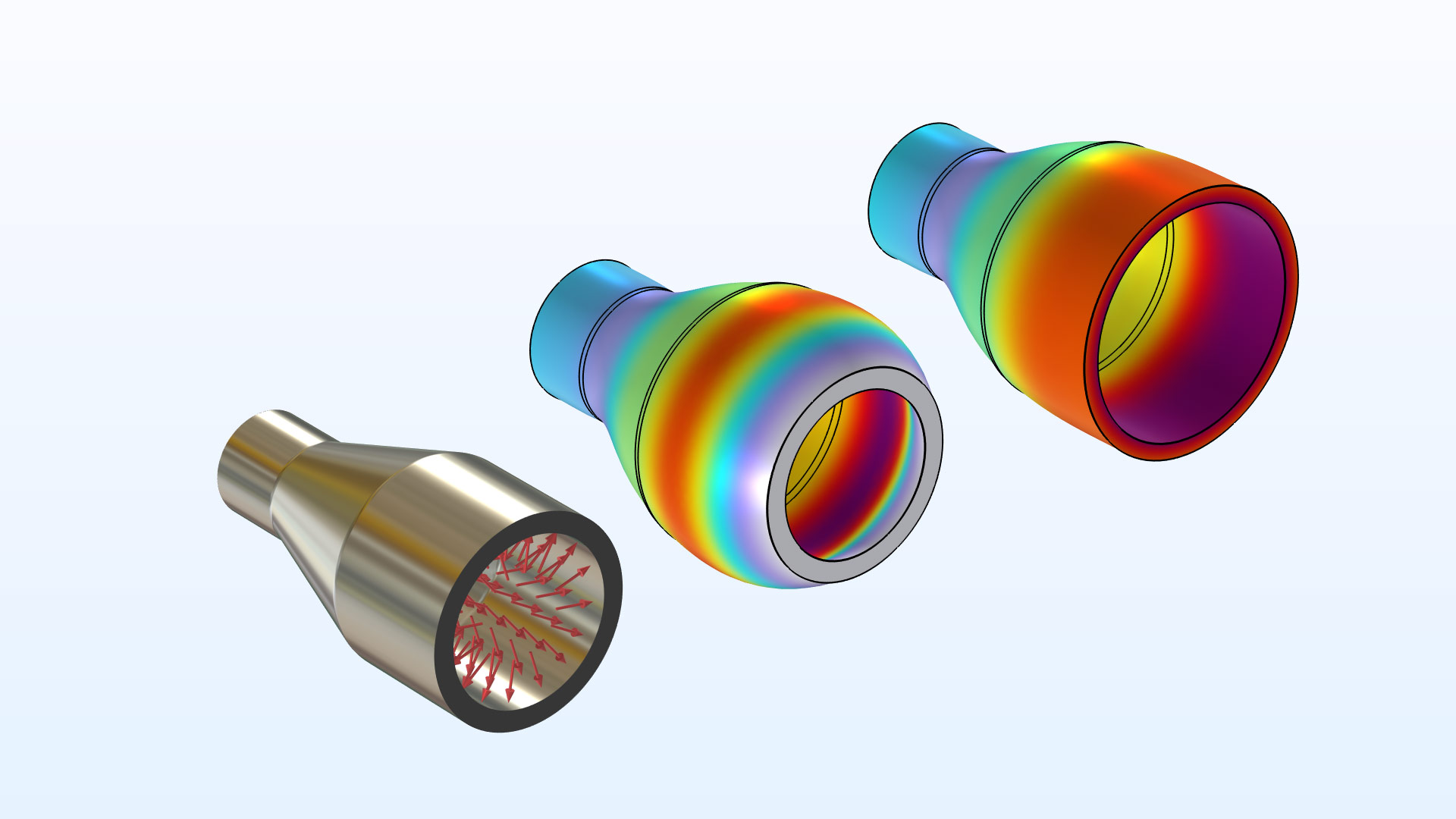
Piping Analysis Enhancements
For the analysis of pipes, the following updates are available:
- In the Pipe Mechanics interface, you can now specify correction factors for flexibility and stresses in pipe bends.
- You can now enter a reduced wall thickness for stress evaluation. This can be used to account for a corrosion allowance.
- In the part libraries, a number of parameterized geometries for pipes have been added: straight pipe, bend, reducer, and T-junction. These geometries can be used for detailed analysis using solid or shell elements. Such 3D models can be directly connected to the Pipe Mechanics interface by using an existing coupling.
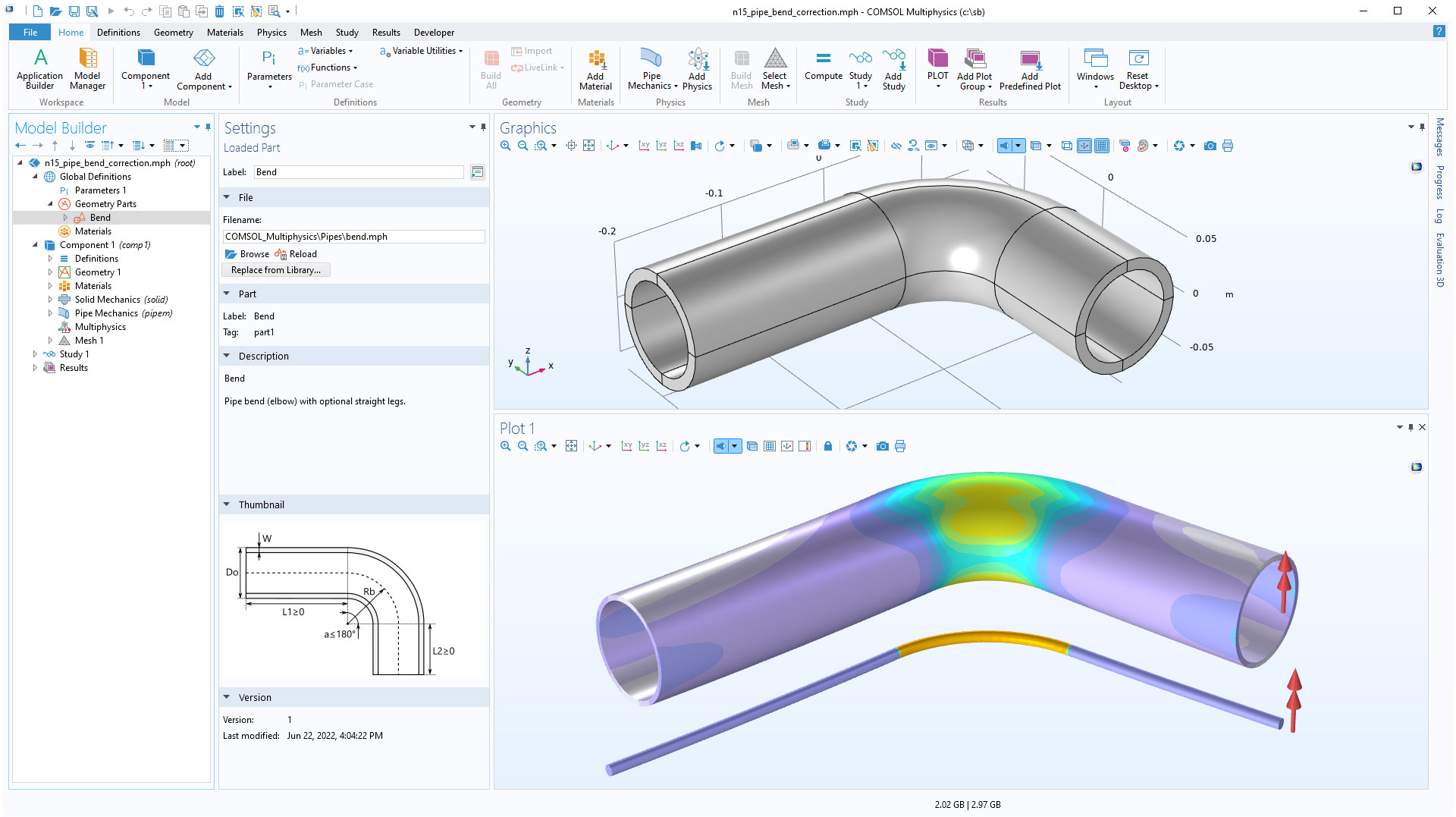
Results in Local Coordinate Systems
It is now easy to define an arbitrary number of local coordinate systems by adding Local System Results nodes for the evaluation of common quantities in the Structural Mechanics interfaces. Among the available transformed quantities, you will find stresses, strains, displacements, and material properties.

Limited Displacement in Truss Interface
In the Truss interface, as well as in the new Wire interface, it is possible to limit the displacement to a certain value for a point or an entire line. The Limited Displacement boundary condition can be used to model a situation where a wall or support point is approached.
Axial forces in a truss under increasing loads. The vertical displacement is limited for two points, as indicated by the black circles. The deformation is magnified by a factor 100.
Standard Cross Sections for Truss Elements
In the Truss interface, the Cross-Section Data node has been augmented with an option for defining the element cross section by geometrical properties. The available cross sections are: Rectangle, Box, Circular, Pipe, H-profile, U-profile, T-profile, C-profile, and Hat. You can see this feature in the new Truss Tower Buckling tutorial model and the following existing models:
Fracture Boundary Condition for Elastic Waves
The new Fracture boundary condition, available in the Elastic Waves, Time Explicit physics interface, is used to treat two elastic domains with imperfect bonding. The fracture can be a thin elastic layer, fluid-filled layer, or discontinuity in elastic materials (an interior boundary). Several options exist for specifying the properties of the thin elastic domain. Typical applications are for modeling nondestructive testing (NDT) applications, such as inspecting the response of delamination regions or other defects, or for modeling wave propagation in fractured solid media in the oil and gas industry.
Predefined Plots
General functionality for predefined plots has brought extensive updates to the Structural Mechanics interfaces. A predefined plot is similar to a default plot, but with the important difference that it is not added to the Model Builder until the user selects to do so. This is advantageous because the number of default plots that are generated for each study has been decreased significantly.
In addition, users will see the following two improvements:
- Several new useful plots are now available from the Add Predefined Plot menu, in addition to the default plots in previous versions.
- Result plots for intermediate study steps — for example the loading step in a prestressed dynamic analysis — are directly available.
Shear Force and Moment Diagrams for Beams
A common way of representing the distribution of bending moments and shear forces in beam structures is with shear force and bending moment diagrams, drawn on top of the geometry. In the Beam interface, a capability to draw moment and shear force diagrams has been added. Even for distributed loads, the graphs are mesh independent; that is, the effect of load variation over the element is included. The section force diagrams can also be used in dynamic analyses, where the loading consists partially of inertial forces.
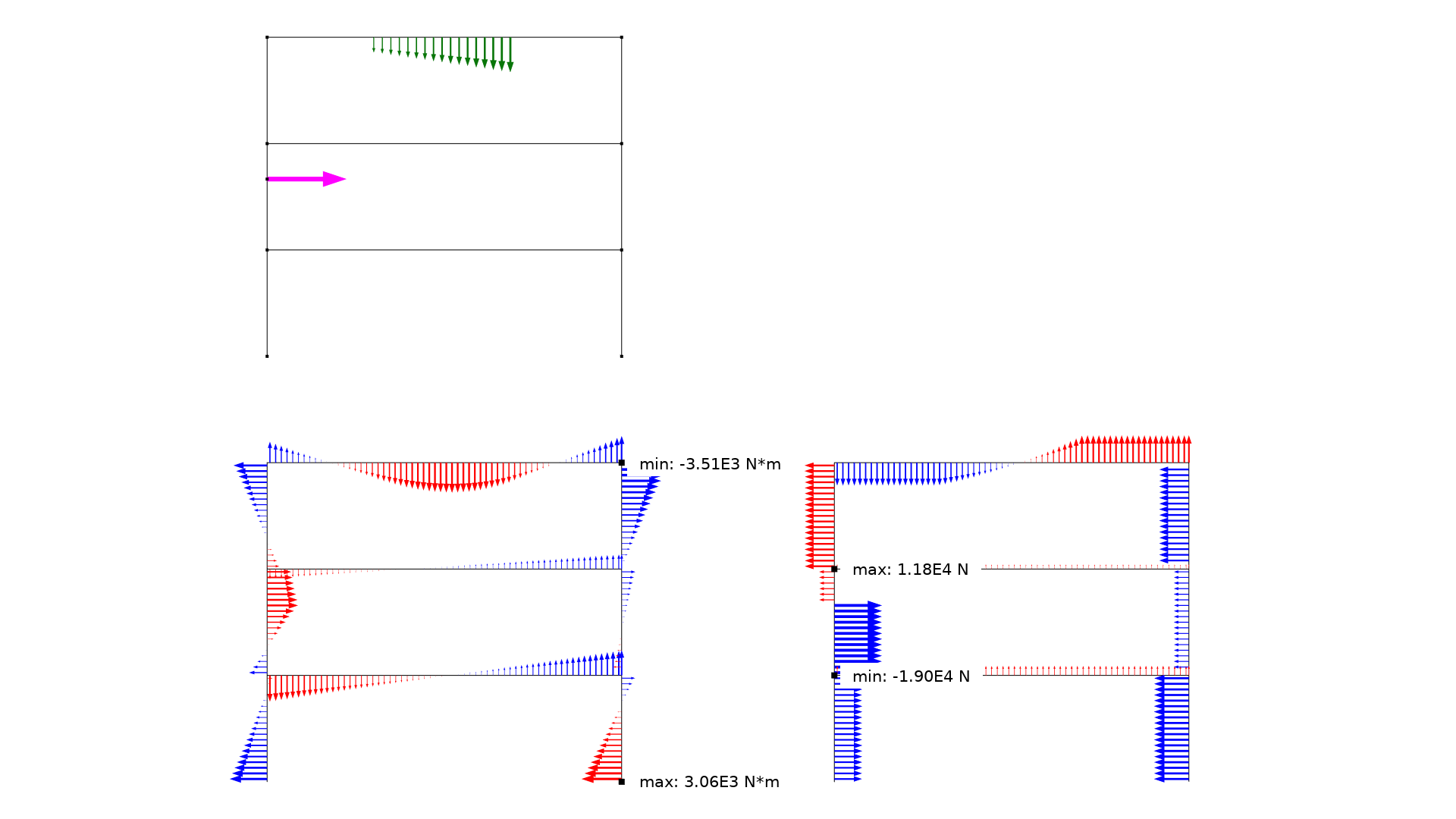
New Parts for Homogenization of Microstructures
In the part libraries, a new folder named Representative Volume Elements has been added to the COMSOL Multiphysics branch. It contains numerous parameterized geometries for common microstructures, such as fibers, pores, and particulate composites. These geometries can be used for computing effective material properties using the representative volume element (RVE) method. The new Homogenized Material Properties of Periodic Microstructures and Micromechanical Model of a Particulate Composite models highlight this new addition.
New Tutorial Models
COMSOL Multiphysics® version 6.1 brings several new tutorial models to the Structural Mechanics Module.
Nonlinear Harmonic Response
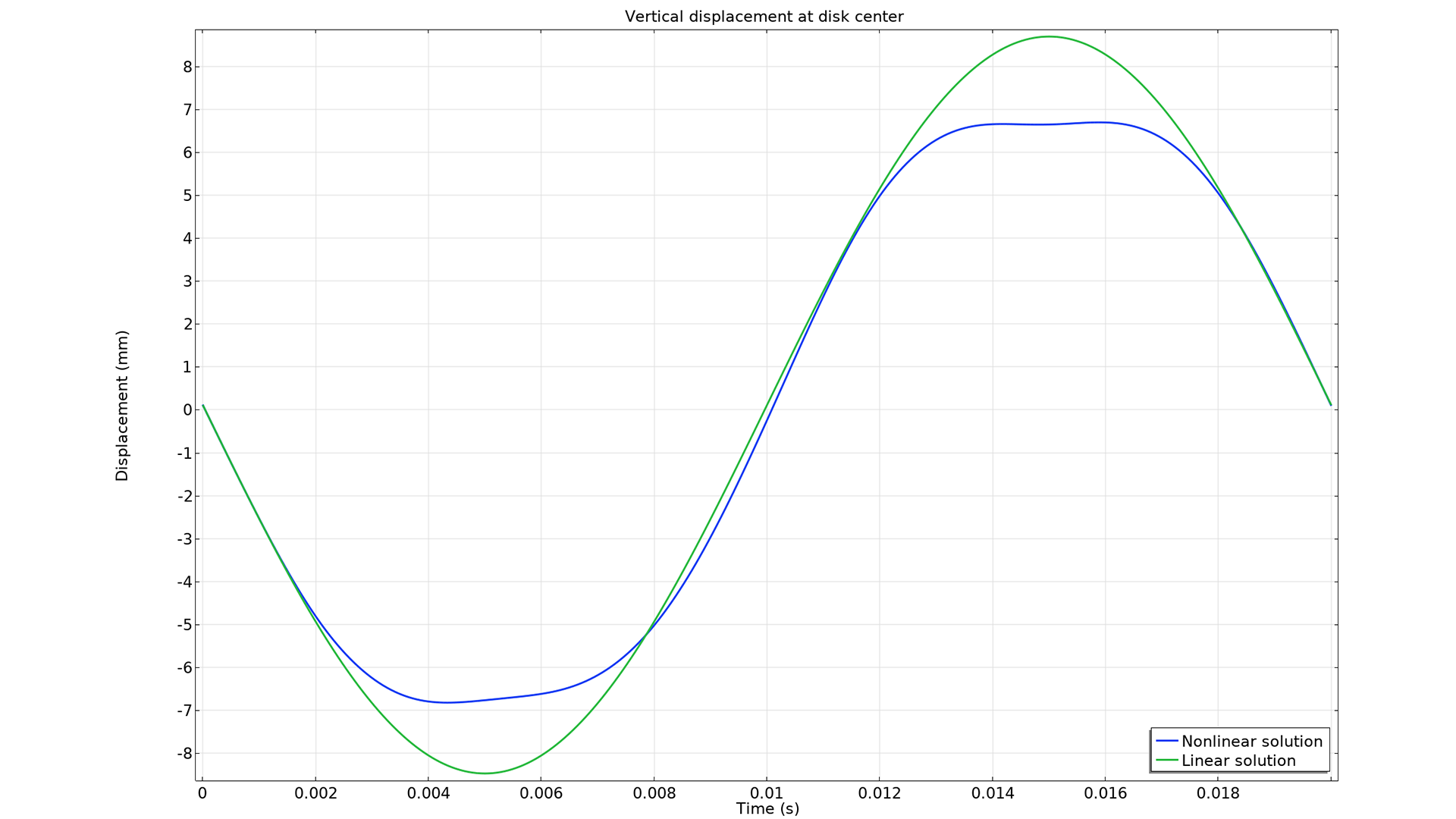
Application Library Title:
nonlinear_harmonic
Download from the Application Gallery
Bracket — Reduced-Order Modeling
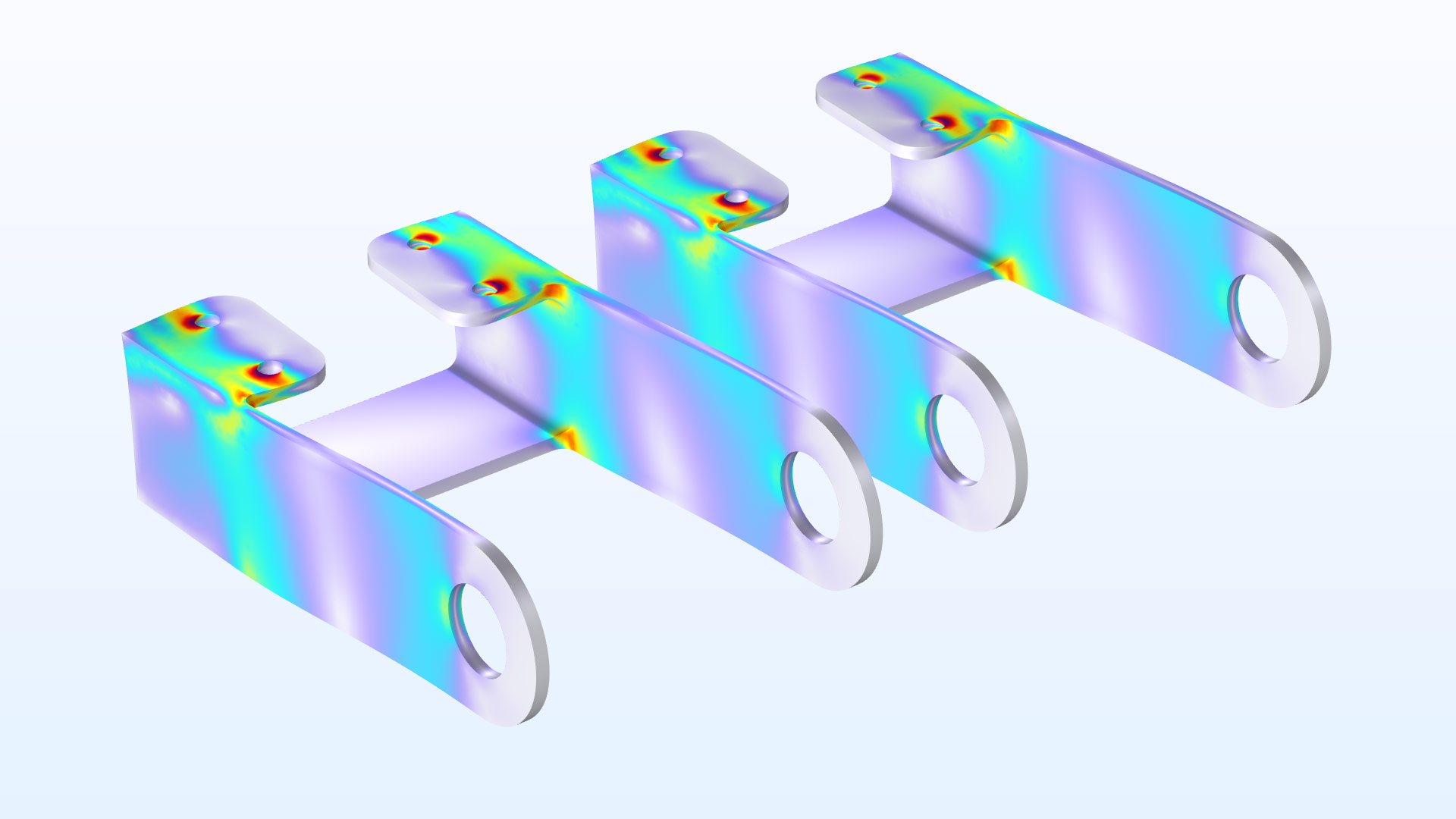
Application Library Title:
bracket_rom
Download from the Application Gallery
Self-Contact of a Loaded Spring
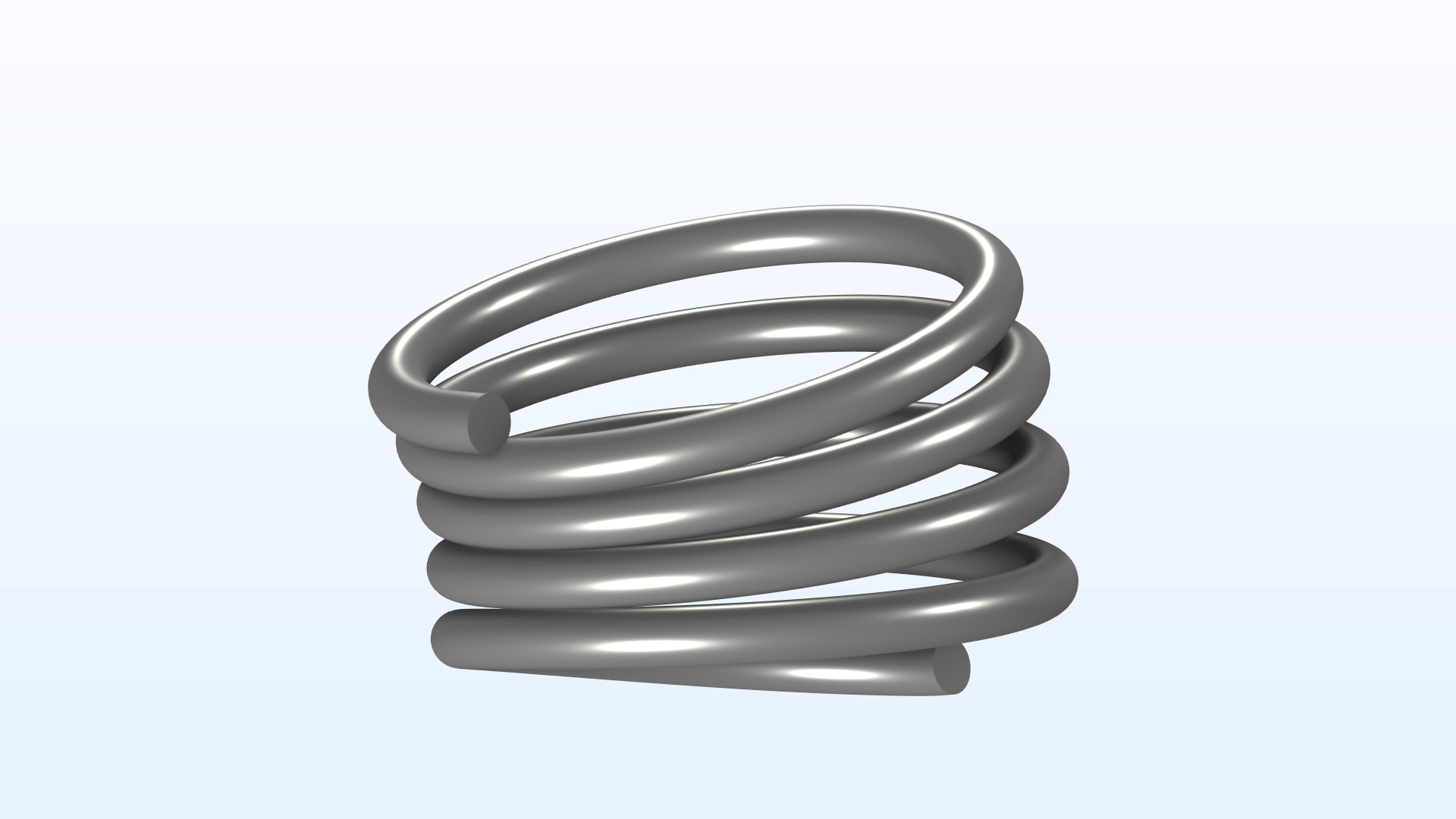
Application Library Title:
loaded_spring_contact
Download from the Application Gallery
Torsion of an Isotropic Cosserat Elastic Cylinder
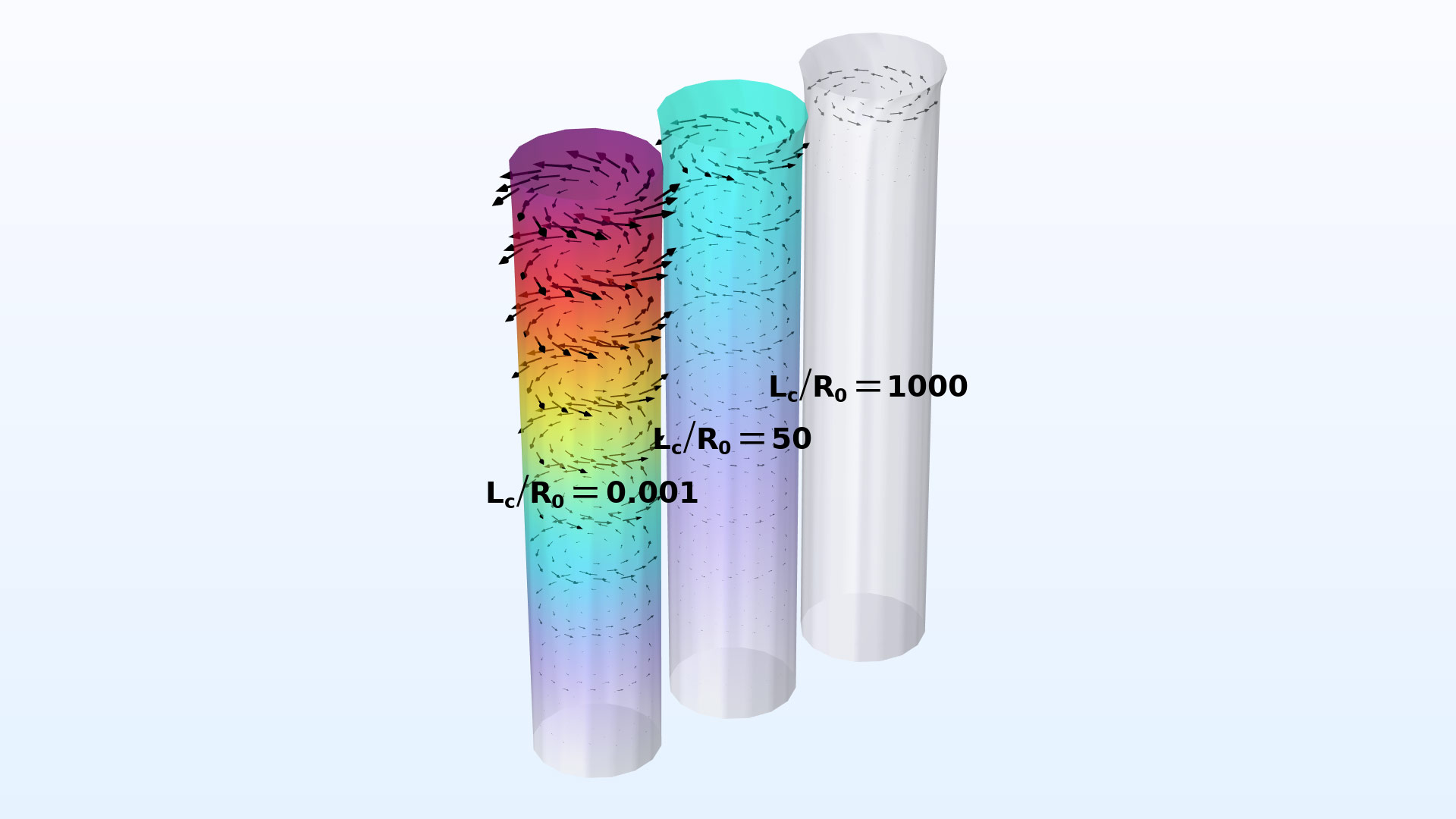
Application Library Title:
cosserat_torsion
Download from the Application Gallery
Micromechanical Model of a Particulate Composite
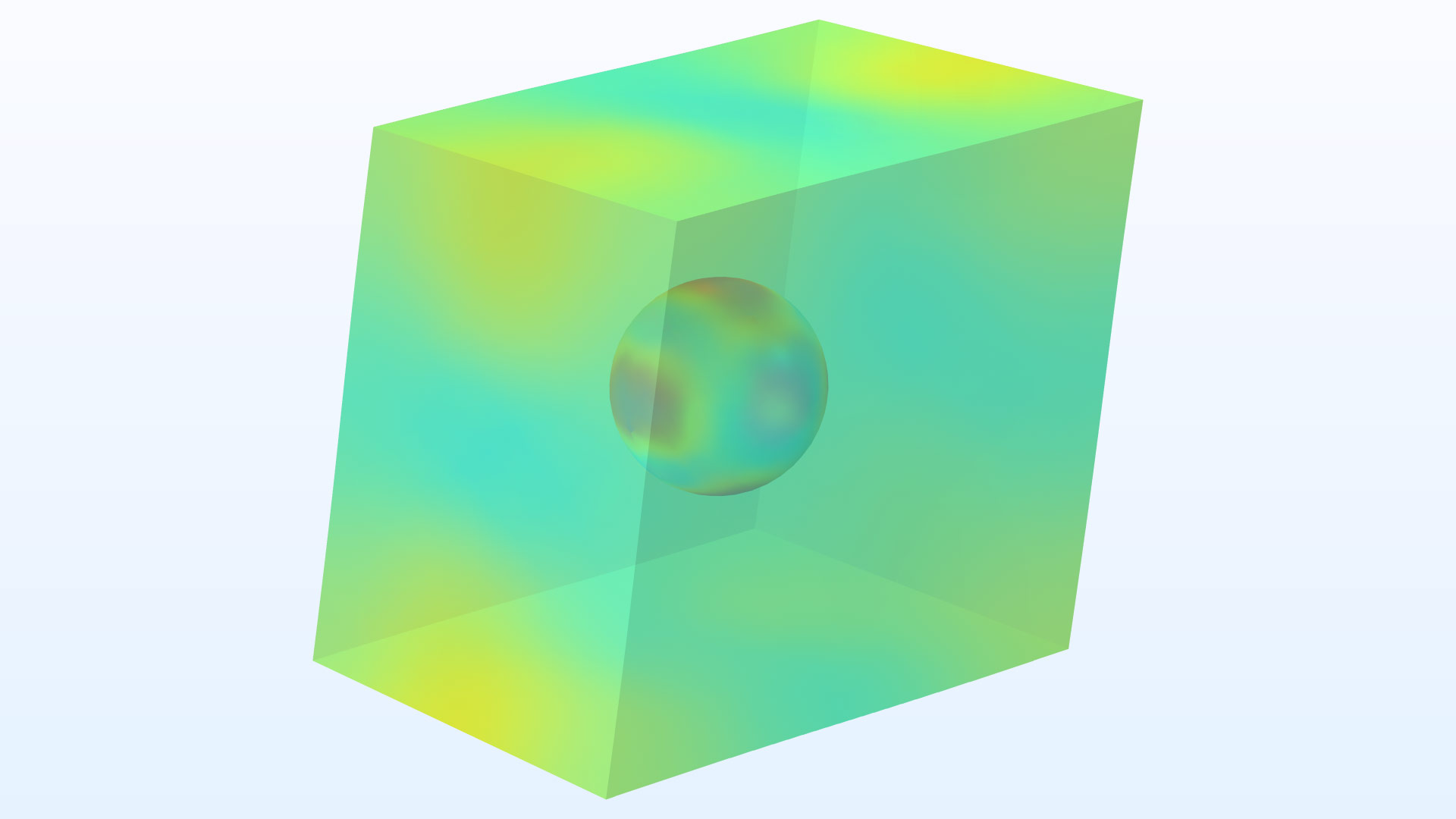
Application Library Title:
micromechanical_model_of_a_particulate_composite
Download from the Application Gallery
Linear Buckling Analysis of a Truss Tower With Dead Loads
Application Library Title:
truss_tower_buckling_guys
Download from the Application Gallery

